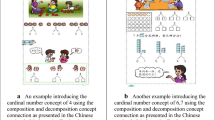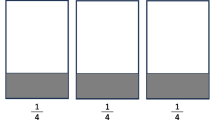Abstract
A central issue in the mathematics curriculum is that we want students to make connections. This issue has been analysed in a series of curricula and instruction design and analysis studies. Moving towards mathematics connections—and away from treating mathematics as a body of isolated concepts and procedures—is an important goal of mathematics education. Although many studies identify “whole number bias” in learning fractions, few studies have examined how this bias may be overcome. In this paper, I aim to clarify how problem variation in Chinese textbooks helps to make concept connections between fractions and whole numbers. To the best of my knowledge, this study systematically addresses the central issue of using the unity of four fraction operations and whole number arithmetic to overcome long-standing whole number bias for the first time. The lack of such methods represents a significant gap in curriculum practice. This study’s framework for understanding variation practice to make connections, with an emphasis on the invariant concepts, also is helpful for the analysis of textbook or instructional design, which represents another significant gap in curriculum development theory.









Similar content being viewed by others
References
An, S. (2008). Outsiders’ views on Chinese mathematics education: A case study on the United States teachers’ teaching experiences in China. Journal of Mathematics Education, 1(1), 1–27.
Ball, D. L. (1990). Prospective elementary and secondary teachers’ understanding of division. Journal for Research in Mathematics Education, 21(2), 132–144.
Bass, H. (2015). Quantities, numbers, number names, and the real number line. In X. H. Sun, B. Kaur, J. Novotna (Eds.), Proceeding of ICMI Study 23: Primary mathematics study on whole number (pp. 10–20).
Brookie, A., Halford, J., Lawrence, A., Tiffen, R., & Wallace, J. (2008). Mathematics and Statistics for the New Zealand curriculum Year 9. Cambridge: Cambridge University Press.
Cai, J., & Nie, B. (2007). Problem solving in Chinese mathematics education: Research and practice. ZDM Mathematics Education, 39(5–6), 459–473.
Charalambous, C. Y., Delaney, S., Hsu, H. Y., & Mesa, V. (2010). A comparative analysis of the addition and subtraction of fractions in textbooks from three countries. Mathematical Thinking and Learning, 12(2), 117–151.
Cockcroft, W. H. (1982). Mathematics counts. London: HM Stationery Office.
Common Core State Standards Initiative. (2010). Common core state standards for mathematics. Washington, DC: National Governors Association Center for Best Practices and the Council of Chief State School Officers.
De Castro, B. V. (2008). Cognitive models: The missing link to learning fraction multiplication and division. Asia Pacific Education Review, 9(2), 101–112.
Duckworth, E. (1979). Learning with breadth and depth. Presented as the Catherine Molony Memorial Lecture. New York: City College School of Education, Workshop Center for Open Education.
Elementary Mathematics Department (2005). Mathematics teacher manual, Grade 1, Vol. 1. Beijing: People Education Press.
Fischbein, E., Deri, M., Nello, M. S., & Marino, M. S. (1985). The role of implicit models in solving verbal problems in multiplication and division. Journal for Research in Mathematics Education, 16(1), 3–17.
Fuson, K. C., Stigler, J. W., & Bartsch, K. (1988). Grade placement of addition and subtraction topics in Japan, mainland China, the Soviet Union, Taiwan, and the United States. Journal for Research in Mathematics Education, 19(5), 449–456.
Graeber, A. O., Tirosh, D., & Glover, R. (1989). Preservice teachers’ misconceptions in solving verbal problems in multiplication and division. Journal for Research in Mathematics Education, 20(1), 95–102.
Guo, S. (2010). Chinese history of science and technology. Beijing: Science Press. [In Chinese].
Kieran, C. (2011). Overall commentary on early algebraization: Perspectives for research and teaching. In J. Cai & E. Knuth (Eds.), Early algebraization: A global dialogue from multiple perspectives (pp. 579–593). New York: Springer.
Kline, M. (1972). Mathematical Thought from Ancient to Modern Times. Oxford: Oxford University Press.
Levin, S. W. (1998). Fractions and division: Research conceptualizations, textbook presentations, and student performances (doctoral dissertation, University of Chicago, 1998). Dissertation Abstracts International 59, 1089A.
Li, Y. (2000). A comparison of problems that follow selected content presentations in American and Chinese mathematics textbooks. Journal for Research in Mathematics Education, 31, 234–241.
Luo, F. (2009). Evaluating the effectiveness and insights of pre-service elementary teachers’ abilities to construct word problems for fraction multiplication. Journal of Mathematics Education, 2(1), 83–98.
Ma, L. (1999). Knowing and Teaching Elementary Mathematics: Teachers’ Understanding of Fundamental Mathematics in China and the United States. Mahwah: Lawrence Erlbaum Associates, Inc.
Ma, L. (2013). A critique of the structure of U.S. elementary school mathematics. Notices of the American Mathematical Society, 60(10), 1282–1296. http://www.ams.org/notices/201310/fea-ma.pdf.
Mack, N. K. (1998). Building a foundation for understanding the multiplication of fractions. Teaching Children Mathematics, 5(1), 34.
Marton, F., & Pang, M. F. (2006). On some necessary conditions of learning. Journal of Learning Sciences, 15(2), 193–220.
Marton, F., Tse, S. K., & Cheung, W. M. (2010). On the Learning of Chinese. Rotterdam: Sense Publishers.
Mathematics Textbook Developer Group for Elementary School. (2014). Mathematics. Beijing: People’s Education Press (In Chinese).
Mayer, R. E., Sims, V., & Tajika, H. (1995). Brief note: A comparison of how textbooks teach mathematical problem solving in Japan and the United States. American Educational Research Journal, 32(2), 443–460.
Ni, Y., & Zhou, Y. D. (2005). Teaching and learning fraction and rational numbers: The origins and implications of whole number bias. Educational Psychologist, 40(1), 27–52.
Nunes, T., Dorneles, B. V., Lin, P. J., & Rathgeb-Schnierer, E. (2016). Teaching and Learning about Whole Numbers in Primary School. ICME-13 Topical Surveys. Cham: Springer.
Rose, A., Tourneau, M., Catherine, D., Burrows, A. V., & Ford, E. R. (1996). New Progress in Mathematics. New York: William H Sadlier.
Rowland, T. (2008). The purpose, design, and use of examples in the teaching of elementary mathematics. Educational Studies in Mathematics, 69(2), 149–163.
Schmidt, W., McKnight, C., & Raizen, S. (1997). A Splintered Vision: An Investigation of U.S. Science and Mathematics Education. Boston: Kluwer.
Sfard, A. (1995). The development of algebra: Confronting historical and psychological perspectives. Journal of Mathematical Behavior, 14, 15–39.
Son, J. W., & Senk, S. L. (2010). How reform curricula in the USA and Korea present multiplication and division of fractions. Educational Studies in Mathematics, 74(2), 117–142.
Stafylidou, S., & Vosniadou, S. (2004). The development of students’ understanding of the numerical value of fractions. Learning and Instruction, 14, 503–518.
Steffe, L. P., & Olive, J. (1990). Constructing fractions in computer microworlds. In G. Booker, G., Cobb, P., & de Mendicuti, T. N. (Eds.), Proceedings of the Fourteenth International Conference for the Psychology of Mathematics Education (pp. 59–66). CONACYT, Mexico City.
Stevenson, H. W., & Stigler, J. W. (1992). The Learning Gap. New York: Summit Books.
Stigler, J. W., Fuson, K. C., Ham, M., & Sook Kim, M. (1986). An analysis of addition and subtraction word problems in American and Soviet elementary mathematics textbooks. Cognition and Instruction, 3(3), 153–171.
Stylianides, G. J. (2009). Reasoning-and-proving in school mathematics textbooks. Mathematical Thinking and Learning, 11(4), 258–288.
Sun, X. (2007). Spiral variation (bianshi) curricula design in mathematics: Theory and practice. Unpublished doctoral dissertation, Hong Kong: The Chinese University of Hong Kong [in Chinese].
Sun, X. (2011a). Variation problems and their roles in the topic of fraction division in Chinese mathematics textbook examples. Educational Studies in Mathematics, 76(1), 65–85.
Sun, X. (2011b). An insider’s perspective: ‘Variation Problems’ and their cultural grounds in Chinese curriculum practice. Journal of Mathematical Education, 4(1), 101–114.
Sun, X. (2016). Spiral Variation: A Hidden Theory to Interpret the Logic to Design Chinese Mathematics Curriculum and Instruction in Mainland China. Singapore: World Scientific (in Chinese).
Sun, X., & Sun, Y. (2012). The systematic model LǛ (
 ) of the nine chapters on the mathematical art and its educational implication in fractional computation. Paper presented at the 12th International Congress on Mathematics Education Seoul, Korea, 8–15 July 2012.
) of the nine chapters on the mathematical art and its educational implication in fractional computation. Paper presented at the 12th International Congress on Mathematics Education Seoul, Korea, 8–15 July 2012.Sun, X. H. (2018). Uncovering Chinese pedagogy: Spiral variation—The unspoken principle of algebra thinking used to develop Chinese curriculum and instruction of the “two basics”. In G. Kaiser, H. Forgasz, M. Graven, A. Kuzniak, E. Simmt & B. Xu (Eds.), Invited Lectures from the 13th International Congress on Mathematical Education. ICME-13 Monographs (pp. 651–667). Cham: Springer.
Sun, X. H., & Bartolini Bussi, M. G. (2018). Language and cultural issues in the teaching and learning of whole number arithmetic. In M. G. Bartolini Bussi & X. H. Sun (Eds.), Building the Foundation: Whole Numbers in the Primary Grades. New York: Springer Press. http://www.springer.com/gp/book/9783319635545.
Sutherland, R., Winter, J., & Harries, T. (2001). A transnational comparison of primary mathematics textbooks: The case of multiplication. Research in Mathematics Education, 3(1), 155–167.
Tirosh, D. (2000). Enhancing prospective teachers’ knowledge of children’s conceptions: the case of division of fractions. Journal for Research in Mathematics Education, 31(1), 5–25.
Venkat, H., Beckmann, S., Larsson, K., Xin, Y. P., Ramploud, A., & Chen, L. (2018). Connecting whole number arithmetic foundations to other parts of mathematics: Structure and structuring activity. In M. Bartolini-Bussi, & X. Sun (Eds.), Building the Foundation: Whole Numbers in the Primary Grades (pp 299–324). Cham: Springer. (New ICMI Study Series).
Vinner, S., Hershkowitz, R., & Bruckheimer, M. (1981). Some cognitive factors as causes of mistakes in the addition of fractions. Journal for Research in Mathematics Education, 12, 70–76.
Wu, H. (1996). The mathematician and the mathematics education reform. Notices of the AMS, 43(12), 1531–1537.
Wu, W. (1995). Mathematics Mechanization: Mechanical Geometry Theorem-Proving, Mechanical Geometry Problem-Solving and Polynomial Equation-Solving. Beijing: Beijing Normal University Press (in Chinese).
Acknowledgements
This study was funded by the research committee of the University of Macau, Macao, China (MYRG2015-00203-FED).
Author information
Authors and Affiliations
Corresponding author
Rights and permissions
About this article
Cite this article
Sun, X.H. Bridging whole numbers and fractions: problem variations in Chinese mathematics textbook examples. ZDM Mathematics Education 51, 109–123 (2019). https://doi.org/10.1007/s11858-018-01013-9
Accepted:
Published:
Issue Date:
DOI: https://doi.org/10.1007/s11858-018-01013-9





 ) of the nine chapters on the mathematical art and its educational implication in fractional computation. Paper presented at the 12th International Congress on Mathematics Education Seoul, Korea, 8–15 July 2012.
) of the nine chapters on the mathematical art and its educational implication in fractional computation. Paper presented at the 12th International Congress on Mathematics Education Seoul, Korea, 8–15 July 2012.